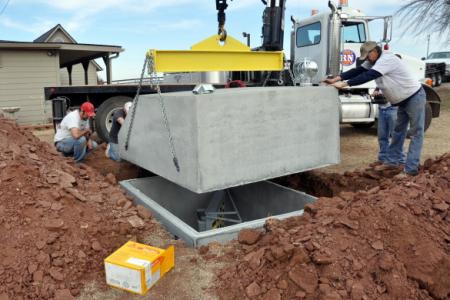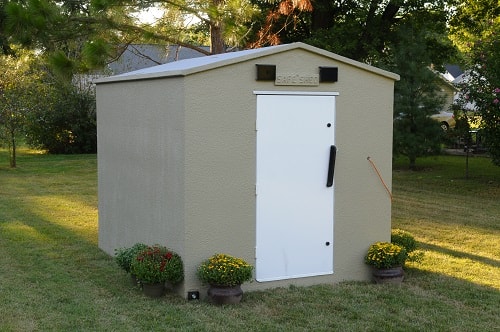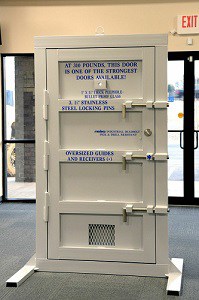[ad_1]
If you live in an area prone to tornadoes or hurricanes, you should consider building your own storm shelter.
Even if you live in a new “modern” home, the materials used to build the house aren’t likely to withstand the high-speed winds of a tornado or hurricane.
A piece of debris flying at 100 mph will smash right through your home, which is why more than half of storm injuries and death are caused by flying debris. And, in a Force 5 or C5 storm, your home could be blown off its foundation.
Read more about hurricane preparedness.
With these tips, a DIY storm shelter can be made much cheaper than you’d imagine.
How Much Do Storm Shelters Cost to Build?
There are many different types of storm shelters and factors that will affect the cost.
The simplest option for a storm shelter is to buy a prefabricated shelter and have them install it. Some of these can even be “dropped in” to your home or yard in just a few hours.
Prefabricated storm shelters are relatively cheap but aren’t the most attractive or comfortable options.
However, these are probably the best options if you aren’t a contractor and are on a budget. Don’t expect it to cost less than $3000, though.
You are more likely to pay around $5-$12k with shipping and installation.
Here are two examples of prefabricated storm shelters:
- Ground Zero Shelters: They sell outdoor underground storm shelters which come ready-made.
- Safe Sheds: These storm shelters are meant for installation outdoors. They weigh 24,000 lbs and are delivered already fabricated. The delivery truck sets them down somewhere outside your home, and that’s it. Since they are so heavy, they can be put just about anywhere and don’t require a reinforced concrete slab. The cost starts at about $5,000.
These are just two examples of prefabricated storm shelters. Again, if you don’t have experience with construction and are on a budget, this is probably the best route.
Don’t risk making a DIY storm shelter if you don’t know what you are doing!
But, if you are up for the task, you can save even more money by building your storm shelter.
The Two Types of DIY Tornado Shelters
All storm shelters can be divided into two main types: Underground and Above Ground.
Underground storm shelters are usually used in tornado zones and often double as bomb shelters. However, underground storm shelters are generally unsuitable for hurricanes because they can flood.
Underground Storm Shelters

The easiest and cheapest way to build your own storm shelter underground is to put it in your existing basement. You can use the existing basement slab floor (assuming it is reinforced and meets FEMA requirements).
If you plan on digging an underground storm shelter outside of your home, then you will need to pay for ground analysis.
Do NOT skip this step. The title of the person who does this is a geotechnical engineer.
The analysis will tell you things like:
- Whether you have high water tables which could floor your storm shelter
- Whether there’s solid bedrock to dig into (this will cost a lot!)
- Whether the freezing soil during winter will create stress on the storm shelter walls
Above-Ground Storm Shelters

You’ll probably be building an above-ground storm shelter if you live in a hurricane area.
What is important to remember when planning these DIY storm shelters is that they must be independent of the home.
This doesn’t mean they can’t be inside your home, but they must be bolted down to the concrete slab. The storm shelter will remain if the rest of your home is blown away.
Location of the Storm Shelter
Storm shelters can be inside your home or outside your home. There are pros and cons to each of these locations.
Storm Shelter Inside the Home
Storm Shelter Outside the Home
Pros
It is easier to bring materials to the build site
You can make a larger storm shelter
Cons
You won’t be able to access the storm shelter as easily during an emergency
The storm shelter can be an eyesore
Note:
According to FEMA building codes, outside storm shelters cannot be more than 150 feet from your home’s entrance. If the storm shelter is further away, you won’t be in compliance or eligible for any rebates.
Size of the Storm Shelter
FEMA recommends that you make your storm shelter a minimum of 7 square feet per person for tornadoes. For hurricanes (which last longer than tornadoes), you should calculate at least 10 square feet per person.
If you plan on furnishing your storm shelter or adding a bathroom, you will need more space. Also, account for supplies you want to include in the storm shelter.
When building an underground storm shelter where you need to dig (i.e., not in a basement), don’t forget that you will need to dig a much bigger hole than the actual storm shelter.
This is because you will need a lot of extra room for working.
Also, don’t forget to consider the thickness of the walls when planning the size of your storm shelter.
If using concrete, the walls should be a minimum thickness of 5 inches – which means your storm shelter will take up much more space in the ground than its interior size.
Materials for Your DIY Storm Shelter
The most common materials for storm shelters are:
- Reinforced concrete, poured
- Reinforced concrete blocks
- Fiberglass and welded solid steel
- Wood and steel
The most practical material choice for DIY storm shelter designs is wood/steel. If you have experience working with concrete, you might attempt a DIY shelter with concrete – but these materials are generally left for contractors.
Don’t expect to find storm-rated steel products at your local hardware store. You will need to special order these from steel suppliers.
The Door Is Going to Cost a Lot

When budgeting your DIY storm shelter, start with the door. This will be a huge part of the expense, and it isn’t something you should skimp on.
Typically, steel doors are used for storm shelters. It isn’t just the door that matters, though. It is how the door is bolted to the frame (and the frame better be ready to withstand a storm, too!). You’ll need heavy-duty hinges.
The door should be able to open inwards so you don’t get trapped by any debris piled against the door.
Funding for Building Your Own Storm Shelter
If you are worried about the costs of building a storm shelter, read about funding grants from FEMA. Some programs refund money spent on pre-disaster planning.
Don’t miss out on an opportunity to save money.
Ready to Get Started?
FEMA has comprehensive guides on how to build your own storm shelter.
Do you have a storm shelter? Share your build experience with us!
[ad_2]
Source link

